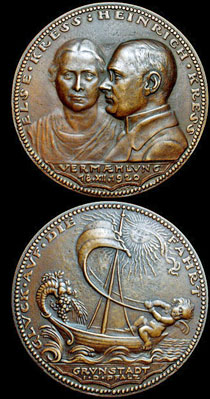|
Mr. Heinrich Kress, a retired senior trade school teacher of Grünstadt in the Palatinate, whose wedding medal(opus 330) was executed by Goetz. Mr. Kress gives a first hand account of his and his wife's visit to Goetz's studio in Munich at the Isabella Strasse address. He says, "Goetz wanted to see our faces as they are in nature. Photographs we had sent him beforehand would not do. They were only useful to arrange the layout of the medal. He welcomed us into his studio with true Bavarian heartiness. The studio contained many lovely antiques, and, as I also am an antique collector, I immediately felt drawn to him as to a kindred soul. Our arrival had interrupted his work, but in no way was he disturbed. The stately man, a warm expression in his dark eyes, was eager to introduce us to the fine points of his art. On a slate like those used by little school children in Germany, he put a lump of plasticine, which he rounded and leveled on the surface.Then he began his work, using intermittently various wooden gravers.He created the outlines and the layout, designed the silhouettes and representations. With pointed, flat, or very fine curved tools, wetting them with his lips from time to time, he finished the last details in the plasticine. Later he made a plaster cast of this creation, bringing it to the utmost perfection. Finally he came to the bronze cast. He brought into play his imagination arranging and executing his materials as his sense of form and color inspired him. Here was a true artist atwork. His creation was graceful in composition and pleasing in design, a permanent memorial for our wedding. One cannot help but be astounded by the delicacy and accuracy of his work. After the first sittings, he continued his work with the help of photographs. But he did not like the retouched pictures as taken by professional photographers. He preferred the amateur photograph. His conscientiousness showed again when another set of pictures was taken of my wife and myself after the personal sitting."
|
 |